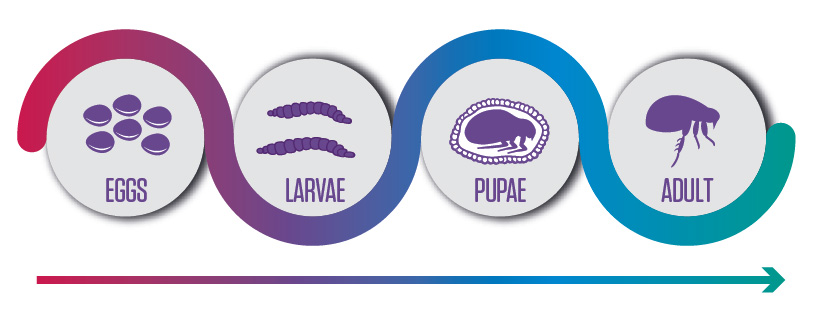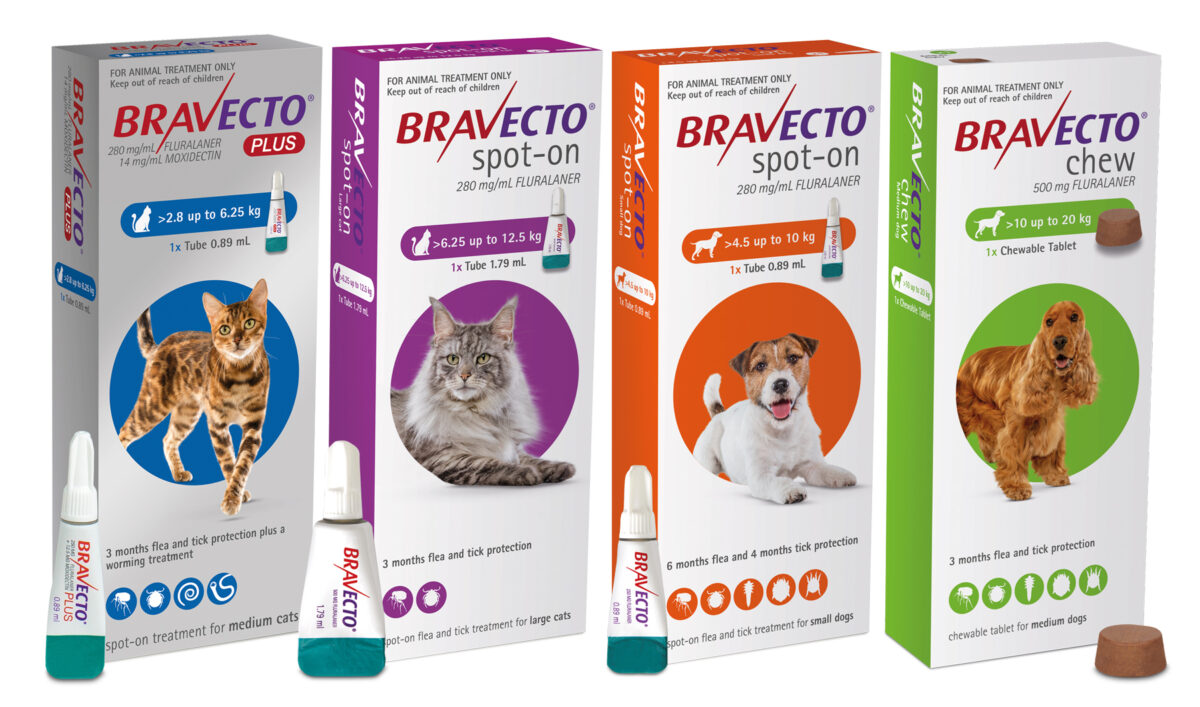Fleas are the most common external parasite in dogs & cats, and whether you live in the city or the country, there are plenty of opportunities for fleas to hitch a ride (and a meal) on your pet, and enter your home.
Fleas cause intense itching and often hair loss or skin infections. They can also carry different diseases that may affect pets and people. Year-round flea preventative products are crucial for keeping fleas off our pets. Because most of the flea population lives in the environment, successful flea treatment must also focus on interrupting the fleas’ life cycle in the home and garden.
Read on to find out how to tell if your pet has fleas and what you can do to successfully treat them.
How to tell if your pet has fleas? Here are 6 signs.
Flea eggs are dropped anywhere a flea-infested pet has been. The good news is early detection can stop fleas from multiplying and causing problems on your pet and in your home.
If you’re wondering how you know if your pet has fleas then read on — here are six signs that they may be hosting unwanted guests in your home.
- Your pet begins to groom excessively or abnormal scratching, licking and/or biting
One of the first signs that your cat has fleas is a change in grooming habits. You may notice that grooming becomes more like an extreme sport than a relaxing pastime for your cat. Excessive grooming, along with licking, chewing, scratching or biting, often leads to an increase in hair loss and sometimes bald spots on the back of your cat’s legs, neck or tail base. And if your dog is scratching, licking or biting these places, it may be an indication of fleas. So if you detect even the slightest change in your pets behaviour, take a closer look at its skin to see if you can discover evidence of any fleas. - Your cat develops red skin lesions or scab-like bumps
When a flea bites your pet, the flea’s mouth parts pierce it’s skin like a needle to feed. The saliva the flea injects may cause an allergic reaction. In some animals the response is subtle, but in others it is severe, and the skin becomes red and inflamed. If you notice red skin lesions or scab-like bumps it is essential to seek help from a veterinarian to reduce inflammation and prevent infection. - Your pet suddenly avoids certain parts of your home
Fleas are not seasonal parasites, as long as the climate is above approximately 15°C and humidity above 50% they can be active. Although that may sound like conditions you’ll find outside in warm weather, those are also conditions you’ll find inside your home year round and if there are fleas in parts of the home your pet may avoid these areas.
Flea eggs and larvae are often found in carpeting, between floor boards and in soft furnishings. It’s important to vacuum thoroughly on a regular basis and make sure to empty the vacuum so the fleas don’t thrive there. If you find fleas, be sure to wash your cat’s bedding with detergent in hot water. Flea pupae can lie dormant for months. - Your pet becomes anxious
Fleas can drive anyone crazy, especially the animal they’re attacking. The constant biting and the resulting itch and irritation may cause a severe shift in your pet’s otherwise pleasant and peaceful demeanour. If you notice your pet becoming increasingly aggressive, irritable, upset or frantic, fleas may be the cause. - You notice tiny pepper-like specks in the fur or in your pet’s bedding
These specks may be flea dirt. It’s one of the most common signs that your cat has fleas. When a flea bites your pet, the flea faeces from the digested blood will appear on their fur or a comb or brush. If you notice these tiny, pepper-like specks, take a sample, place it on a white paper towel or cloth and mist it with water. If the sample turns red, it is likely flea dirt. - You see pinhead-sized black or reddish-brown insects crawling in your pet’s fur
If you see this, you’re looking at the fleas themselves! If your pet is suffering from a heavy flea infestation, you may be able to see fleas. These are usually rapidly moving. You can check their fur for fleas by checking the skin after parting the hair. Fleas tend to gravitate towards lower back, hind legs, and stomach so be sure to check these areas carefully.
What to do if my pet has fleas
The flea lifecycle takes on average between 3 and 8 weeks and is made up of four stages – egg, larvae, pupae and adult. Of these, only the adult flea lives on the pet, while all the immature fleas lurk in places like bedding, carpet and between floorboards. Female adult fleas can lay up to 50 eggs per day. About 95% of a household’s flea problem consists of immature stages in the environment, with the remaining 5% representing the adult fleas seen on the pet.1 There can be a time lag of several months before an egg is hatched, which means that fleas seen on the pet developed from eggs that were laid weeks to months ago.
Flea Lifecycle
Usually 3 to 8 weeks, can be >3 months

Check your dog or cat for fleas regularly. Fleas are not seasonal parasites, as long as the climate is above approximately 15°C and humidity above 50% they can be active. If you suspect your dog has fleas, consult a veterinarian. If fleas are confirmed, other pets in your household will need treatment too. You also may need to treat your home. Frequent vacuuming and washing of your pet’s bedding can decrease the number of fleas in your home.
How to stop the flea lifecycle
It’s important to know that fleas are remarkably resilient little pests, their pupae can stay dormant for months before hatching into fleas and latching onto your pet or other family members and restarting their entire life cycle all over again. To eliminate fleas you need to treat with an effective option for at least 3 months without any gaps in treatment. Three months’ protection is ideal for eliminating those fleas present at the time of treatment, AND those that may hatch in the near future. Your vet can recommend treatment options.

Control fleas with an effective long-lasting treatment
The only thing that can get rid of fleas is flea control for all pets in the household, that is administered consistently. Ensure that all pets in a household are on year-round, effective flea control that is administered regularly according to label instructions. Bravecto Chew for dogs, Bravecto Plus and Bravecto Spot-on for cats deliver 3 months of effective flea control with just one dose, and Bravecto spot-on for dogs provides an amazing 6 months flea control! This means that for both cats and dogs, one dose of Bravecto kills fleas before they lay eggs and lasts longer than the average flea life cycle. Ongoing administration of Bravecto products as per label recommendations will ensure that an infestation does not return.

If you follow these steps, your dog should be flea-free before you know it!















Community